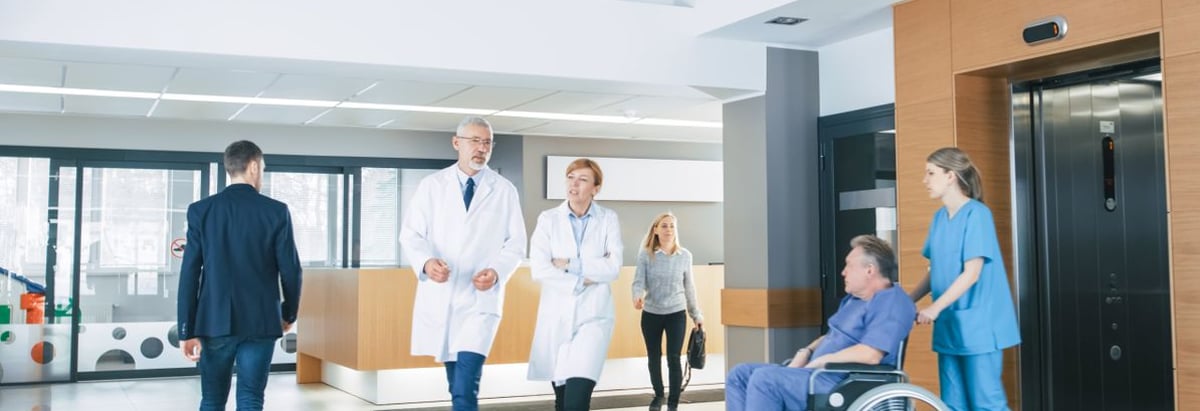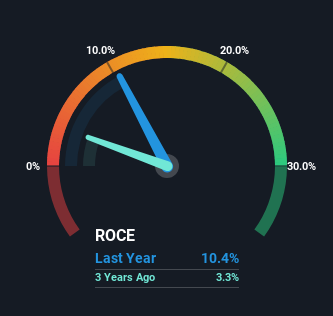- Saudi Arabia
- /
- Healthcare Services
- /
- SASE:4009
Investors Will Want Middle East Healthcare's (TADAWUL:4009) Growth In ROCE To Persist

Did you know there are some financial metrics that can provide clues of a potential multi-bagger? Firstly, we'd want to identify a growing return on capital employed (ROCE) and then alongside that, an ever-increasing base of capital employed. This shows us that it's a compounding machine, able to continually reinvest its earnings back into the business and generate higher returns. So when we looked at Middle East Healthcare (TADAWUL:4009) and its trend of ROCE, we really liked what we saw.
What Is Return On Capital Employed (ROCE)?
If you haven't worked with ROCE before, it measures the 'return' (pre-tax profit) a company generates from capital employed in its business. To calculate this metric for Middle East Healthcare, this is the formula:
Return on Capital Employed = Earnings Before Interest and Tax (EBIT) ÷ (Total Assets - Current Liabilities)
0.10 = ر.س420m ÷ (ر.س5.3b - ر.س1.2b) (Based on the trailing twelve months to June 2024).
Thus, Middle East Healthcare has an ROCE of 10%. In absolute terms, that's a pretty standard return but compared to the Healthcare industry average it falls behind.
Check out our latest analysis for Middle East Healthcare

In the above chart we have measured Middle East Healthcare's prior ROCE against its prior performance, but the future is arguably more important. If you'd like to see what analysts are forecasting going forward, you should check out our free analyst report for Middle East Healthcare .
What Can We Tell From Middle East Healthcare's ROCE Trend?
The trends we've noticed at Middle East Healthcare are quite reassuring. The data shows that returns on capital have increased substantially over the last five years to 10%. The company is effectively making more money per dollar of capital used, and it's worth noting that the amount of capital has increased too, by 81%. So we're very much inspired by what we're seeing at Middle East Healthcare thanks to its ability to profitably reinvest capital.
The Key Takeaway
All in all, it's terrific to see that Middle East Healthcare is reaping the rewards from prior investments and is growing its capital base. And with the stock having performed exceptionally well over the last five years, these patterns are being accounted for by investors. In light of that, we think it's worth looking further into this stock because if Middle East Healthcare can keep these trends up, it could have a bright future ahead.
One final note, you should learn about the 2 warning signs we've spotted with Middle East Healthcare (including 1 which is potentially serious) .
While Middle East Healthcare isn't earning the highest return, check out this free list of companies that are earning high returns on equity with solid balance sheets.
New: Manage All Your Stock Portfolios in One Place
We've created the ultimate portfolio companion for stock investors, and it's free.
• Connect an unlimited number of Portfolios and see your total in one currency
• Be alerted to new Warning Signs or Risks via email or mobile
• Track the Fair Value of your stocks
Have feedback on this article? Concerned about the content? Get in touch with us directly. Alternatively, email editorial-team (at) simplywallst.com.
This article by Simply Wall St is general in nature. We provide commentary based on historical data and analyst forecasts only using an unbiased methodology and our articles are not intended to be financial advice. It does not constitute a recommendation to buy or sell any stock, and does not take account of your objectives, or your financial situation. We aim to bring you long-term focused analysis driven by fundamental data. Note that our analysis may not factor in the latest price-sensitive company announcements or qualitative material. Simply Wall St has no position in any stocks mentioned.
About SASE:4009
Middle East Healthcare
A healthcare provider, owns and operates a network of hospitals under the Saudi German Hospital name in the Middle East and North Africa.
Very undervalued with proven track record.
Market Insights
Community Narratives




